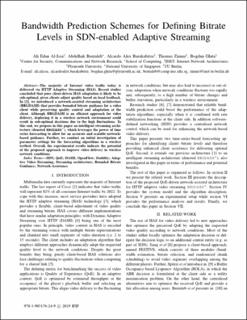| dc.contributor.author | Alissa, Ali | |
| dc.contributor.author | Bentaleb, Abdelhak | |
| dc.contributor.author | Barakabitze, Alcardo | |
| dc.contributor.author | Ghita, Bogdan V. | |
| dc.contributor.author | Zinner, Thomas | |
| dc.date.accessioned | 2020-03-20T12:25:34Z | |
| dc.date.available | 2020-03-20T12:25:34Z | |
| dc.date.created | 2019-12-20T14:36:49Z | |
| dc.date.issued | 2019 | |
| dc.identifier.isbn | 978-3-903176-24-9 | |
| dc.identifier.uri | https://hdl.handle.net/11250/2647856 | |
| dc.description.abstract | The majority of Internet video traffic today is delivered via HTTP Adaptive Streaming (HAS). Recent studies concluded that pure client-driven HAS adaptation is likely to be sub-optimal, given clients adjust quality based on local feedback. In [1], we introduced a network-assisted streaming architecture (BBGDASH) that provides bounded bitrate guidance for a video client while preserving quality control and adaptation at the client. Although BBGDASH is an efficient approach for video delivery, deploying it in a wireless network environment could result in sub-optimal decisions due to the high fluctuations. To this end, we propose in this paper an intelligent streaming architecture (denoted BBGDASH + ), which leverages the power of time series forecasting to allow for an accurate and scalable networkbased guidance. Further, we conduct an initial investigation of parameter settings for the forecasting algorithms in a wireless testbed. Overall, the experimental results indicate the potential of the proposed approach to improve video delivery in wireless network conditions. | en_US |
| dc.language.iso | eng | en_US |
| dc.publisher | Institute of Electrical and Electronics Engineers (IEEE) | en_US |
| dc.relation.ispartof | 15th International Conference on Network and Service Management, CNSM 2019 | |
| dc.title | Bandwidth Prediction Schemes for Defining Bitrate Levels in SDN-enabled Adaptive Streaming | en_US |
| dc.type | Chapter | en_US |
| dc.description.version | acceptedVersion | en_US |
| dc.identifier.doi | 10.23919/CNSM46954.2019.9012713 | |
| dc.identifier.cristin | 1763439 | |
| dc.description.localcode | © 2019 IEEE. Personal use of this material is permitted. Permission from IEEE must be obtained for all other uses, in any current or future media, including reprinting/republishing this material for advertising or promotional purposes, creating new collective works, for resale or redistribution to servers or lists, or reuse of any copyrighted component of this work in other works. | en_US |
| cristin.unitcode | 194,63,30,0 | |
| cristin.unitname | Institutt for informasjonssikkerhet og kommunikasjonsteknologi | |
| cristin.ispublished | true | |
| cristin.fulltext | postprint | |
| cristin.qualitycode | 1 | |
